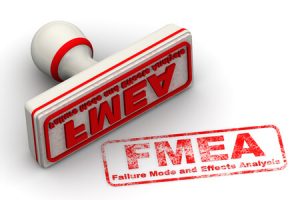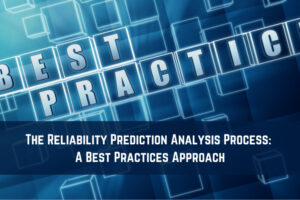An innovative, unique-to-Relyence feature, Knowledge Banks are a powerful way to efficiently manage your FMEA data. Since their introduction, Knowledge Banks have remained one of the most popular and widely praised capabilities of the Relyence platform. A pioneering solution for data reusability and consistency, Relyence Knowledge Banks often play a central role in Failure Mode & Effects Analyses (FMEA).
Due to the inherent flexibility built into Knowledge Banks, it is helpful to review your specific needs and then determine how you can best utilize Knowledge Banks. Our technical support team has compiled a list of the most asked questions regarding Knowledge Banks. This article provides the answers to these FAQs in order to help you set up your Knowledge Banks.
Question #1: Why Should I Use Knowledge Banks?
Failure Mode and Effects Analyses (FMEAs) encompass a large amount of data. Oftentimes, you can reuse that information (or subsets of that data) in similar designs or processes. By incorporating data reuse into your FMEAs, your analyses can not only perform more efficiently, but also will be more consistent. A Knowledge Bank provides the capability of storing FMEA data. You can then access this databank of information across analyses for easy reuse and quick analysis completion. This is one of the primary roles for using FMEA Knowledge Banks.
Additionally, Knowledge Banks support the ability to push and pull data to and from the databank. For example, you may be performing Failure Modes and Effects analyses on two different products, Product A and Product B, which happen to share a component subsystem. In this case, you can store the FMEA data for the shared subsystem in the Knowledge Bank. Then, Product A and Product B both access the Knowledge Bank to incorporate the shared subsystem data for their respective FMEAs. Now consider that at some point in the analysis process for Product A, some information for the shared subsystem is updated. Once the modifications are complete, the data can be pulled into the Knowledge Bank from the updated Product A FMEA. Then, that information can be pushed out to the FMEA for Product B. This key Knowledge Bank functionality ensures that all your FMEAs remain up-to-date and in sync.
Another benefit of Knowledge Banks is that they ensure that important knowledge is captured and that lessons learned are retained. Knowledge Banks are intended to grow over time, collecting and storing critical information. Because teams change, processes evolve, and products designs are continually updated, this historical tracking is vital to maintaining accumulated knowledge.
Importantly, using Knowledge Banks enables your FMEAs to be completed far more efficiently, leading to reduced costs. Because data can be reused easily and is kept consistent, your overall FMEA process is streamlined for both efficiency and effectiveness. This results in FMEA completion in less time, thereby saving your team time and minimizing costs.
Lastly, it is also important to note that Knowledge Banks fully support the requirements for Foundation FMEAs, enabling you to meet the requirements established in the AIAG & VDA FMEA Handbook for Failure Mode and Effects Analyses.

Question #2: How Do I Use Knowledge Banks with DFMEAs?
Design FMEAs, or DFMEAs, are used to perform failure risk assessments on products. For this reason, DFMEAs are typically organized by physical subsystems using a hierarchical breakdown. In Relyence FMEA, this breakdown is established using the Analysis Tree. Then, specific FMEA Worksheets for each item in the tree is completed.
The Knowledge Bank can then be built up using the specific Analysis Tree items. Using a drone as an example, you can populate a Knowledge Bank with data for the components of the drone: the main circuit board, GPS, ground controller, etc. All the FMEA Worksheet information—as well as any other related data associated with the subsystem such as the Boundary Diagram and DVP&R—is stored in the Knowledge Bank for reuse.
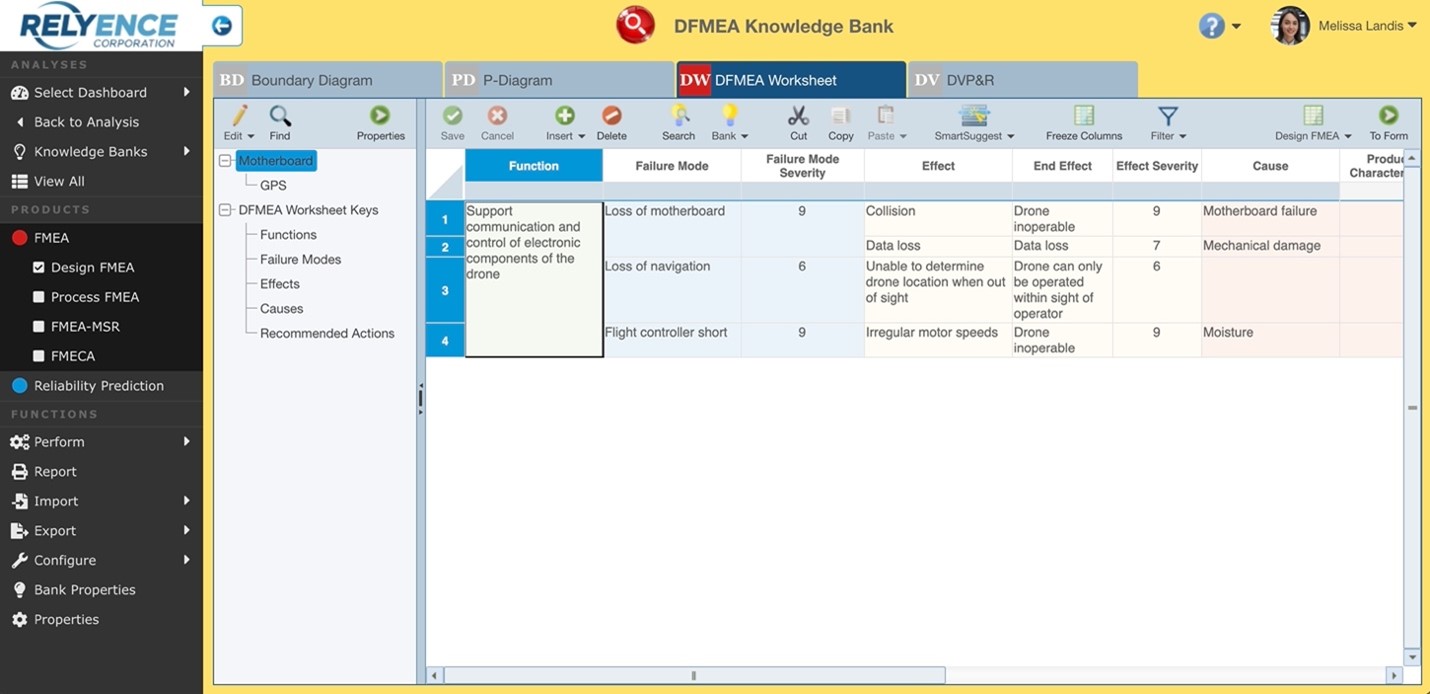
All FMEA Worksheet data —as well as any other related data such as the Boundary Diagram and DVP&R—is stored in the Knowledge Bank for reuse.
Question #3: How Do I Use Knowledge Banks with PFMEAs?
Process FMEAs, or PFMEAs, are used to perform failure risk assessments on processes. For this reason, PFMEAs are typically organized by operations or processes, such as grinding, heat treating, and painting. In Relyence FMEA, this breakdown is established using the Analysis Tree. Then, specific FMEA Worksheets for each process is completed.
The Knowledge Bank can then be built up using the specific processes defined in the Analysis Tree. In the example drone case, you can populate the Knowledge Bank with data of the various processes related to manufacturing the drone. All the FMEA Worksheet information for the process—as well as related data such as the Process Flow Table and Control Plan—is stored in the Knowledge Bank for reuse.
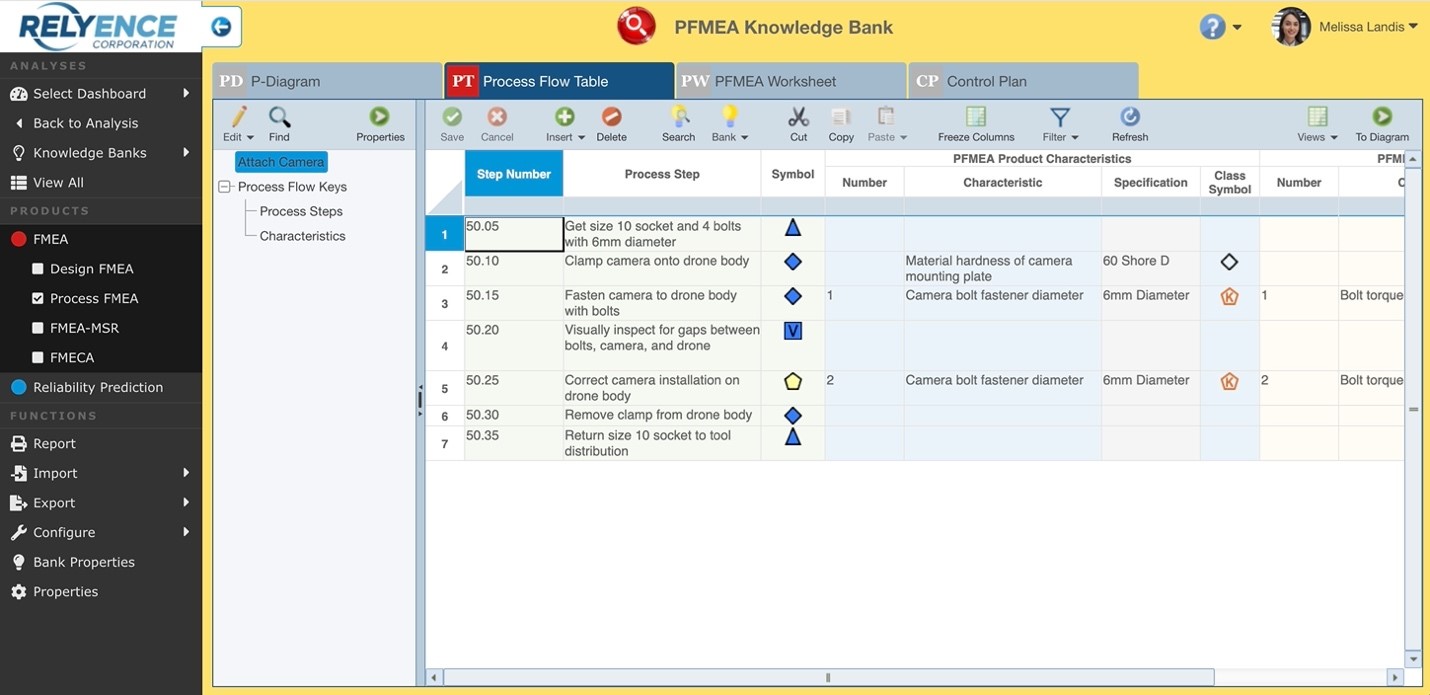
When using Knowledge Banks with PFMEA, all the FMEA Worksheet, Process Flow, and Control Plan data is stored in the Knowledge Bank for reuse.
Question #4: How Should I Set Up My Knowledge Banks If I Perform Both DFMEA and PFMEA?
In some cases, when the quantity of FMEA data is relatively small and the number of analysts performing FMEAs is also small, a single well-organized Knowledge Bank may suffice. Even if you are performing different types of FMEA (such as DMEAs and PFMEAs) a single Knowledge Bank can store data from each type.
One of the best ways to organize the data in this case is to have one Analysis Tree branch for DFMEA data and a second Analysis Tree branch for PFMEA data, so that your Knowledge Bank looks something like this:
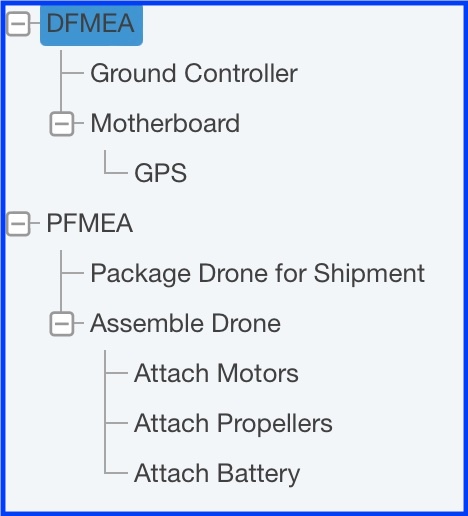
Another approach is to establish two separate Knowledge Banks: one for DFMEA and one for PFMEA. This approach can be useful when different teams perform DFMEA and PFMEA. This can be a beneficial approach for data management and control.
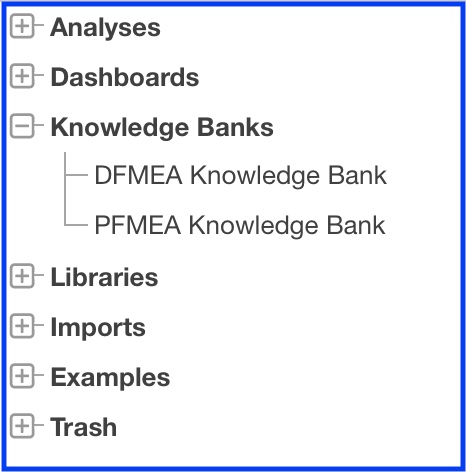
You can select from either approach depending upon your preference. Either approach offers all the advantages Knowledge Banks provide.
Question #5: When Should I Use Multiple Knowledge Banks?
There are many reasons why it is sometimes advantageous to use more than one Knowledge Bank. Though using a single Knowledge Bank is the simplest method, it may be a more well-managed approach to establish multiple Knowledge Banks.
One common reason for using separate Knowledge Banks is when performing both DFMEA and PFMEA . Especially if these teams are separate, using a single Knowledge Bank for DFMEA data and a separate Knowledge Bank for PFMEA data helps to keep FMEA information well-organized.
Another common use case for more than one Knowledge Bank is when there are multiple business locations and teams that operate independently. This also provides a more streamlined, efficient approach for FMEA data handling.
Similarly, organizing Knowledge Banks by business unit may be a better approach for some organizations. For example, a manufacturer may produce engines for both military and commercial use. If those business units do not overlap, the data can be easily stored in separate Knowledge Banks based on the business unit.
A key reason for establishing multiple Knowledge Banks is to have the ability to control access to Knowledge Bank data. Using the example given above, the unit tasked with military engine analysis might need have their data secure. Combining multiple Knowledge Banks with Permission and Access Control capabilities in Relyence, you can meet this need.
The most common approach our team has seen for multiple Knowledge Banks set up is based on location or business unit. However, the determination for how to set up multiple Knowledge Banks ultimately depends on your organization’s structure and needs.
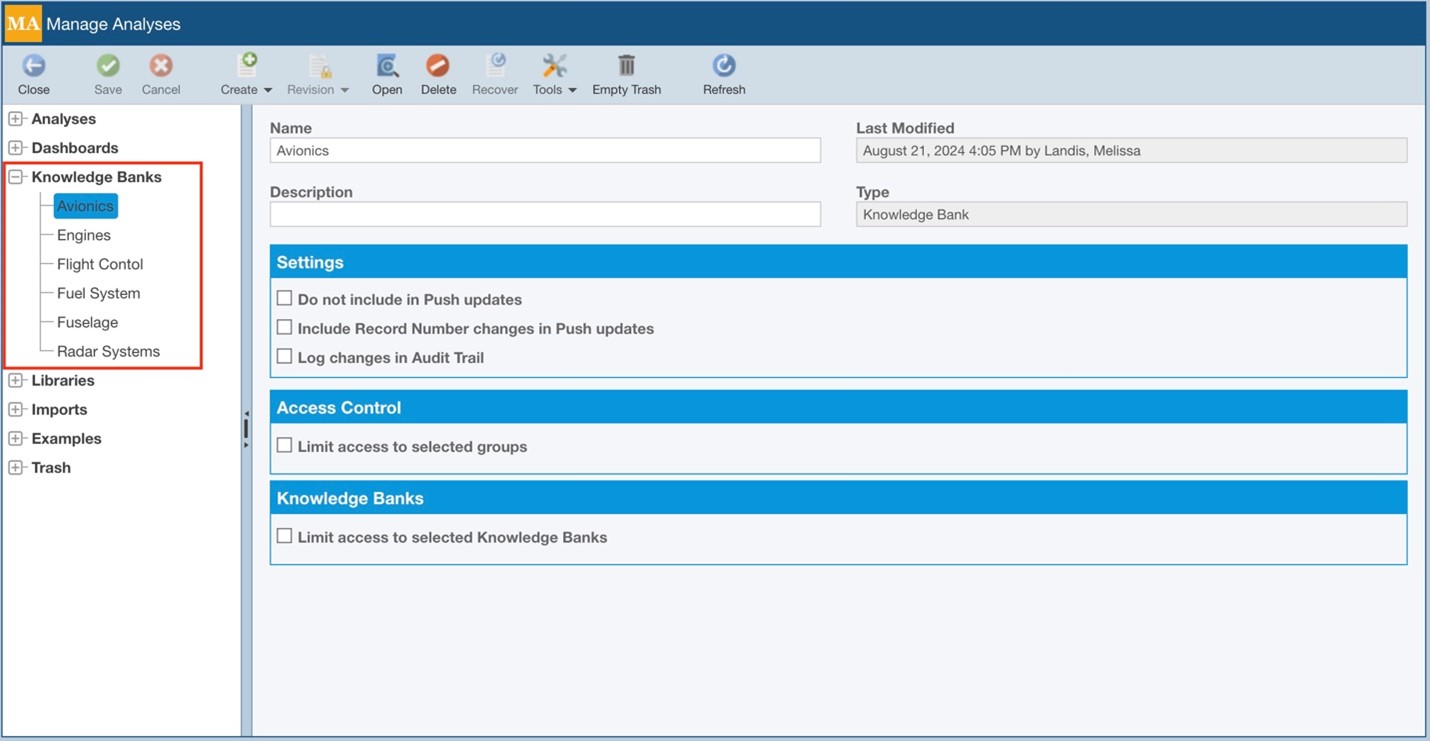
Based on your organization’s needs, there are many reasons why it is can be advantageous to use more than one Knowledge Bank in Relyence.
Question #6: When Should I Use a Hierarchy of Knowledge Banks?
In some cases, multiple Knowledge Banks are used in order to separate disparate data into individual Knowledge Banks for better organization and easier use. However, in some cases it may be helpful to have multiple Knowledge Banks that are still linked in some manner. As an example, assume you are analyzing the manufacturing processes at a plant that produces two unique product lines—washers and dryers. Using multiple Knowledge Banks set up in a hierarchical manner can be useful in such a case. For this example, you could set up an Appliance Knowledge Bank which includes information that applies to both the washer and dryer product lines. In addition, you would establish a Washer Knowledge Bank the includes data specific to washers, and a Dryer Knowledge Bank that includes the details for the dryers.
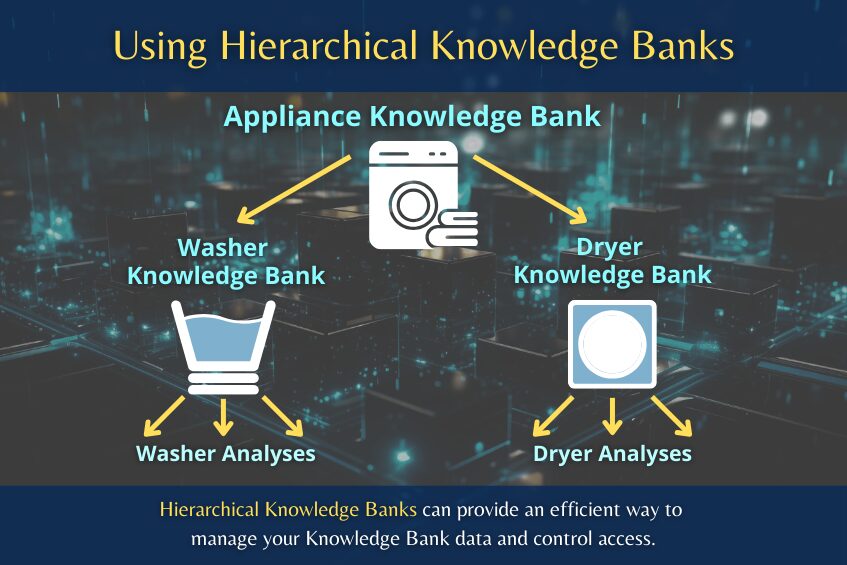
Similarly, the hierarchical approach could apply for a situation where there is a Knowledge Bank that stores global and corporate-wide applicable FMEA details, along with location-specific Knowledge Banks. As needed, the details in the global Knowledge Bank can be incorporated in the location-specific Knowledge Banks.
Question #7: How Do You Recommend I Organize my Knowledge Banks?
Though the best way to set up and manage your Relyence Knowledge Banks is determined by your specific needs, our Relyence support team has seen some common patterns emerge.
In most single user or small business cases, the choice is typically to use a single Knowledge Bank. In these cases, the number of users and number of analyses performed is small and easily managed, so the simplicity of a single Knowledge Bank is preferred.
When performing different types of FMEAs (such as DFMEA and PFMEA) most users decide to use multiple Knowledge Banks: one for DFMEAs and one for PFMEAs. Due to the varying nature of these analyses, the separation of Knowledge Bank data makes organizational sense. Additionally, when a company has defined business units or locations, it is common for multiple Knowledge Banks to be established based on these groupings.
Lastly, though not as common, if an organization is very large and wants to provide a global Knowledge Bank along with more specific Knowledge Banks, or desires to control Knowledge Bank access, a hierarchal Knowledge Bank structure is set up. When this approach is selected, it is typically set up and managed by an administrator or team leader who has oversight of the business as a whole.
Conclusion
If you have further questions about Relyence Knowledge Banks usage and capabilities, please feel free to reach out to our knowledgeable and helpful technical support team. We are happy to help!
Sign up today for a no-hassle, completely free software trial if you are interested in learning more about Knowledge Banks, Relyence FMEA, or any of the Relyence Studio products. Contact us to discuss your needs or to schedule a free personalized Relyence tour.




